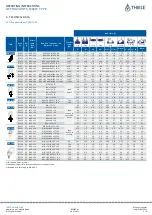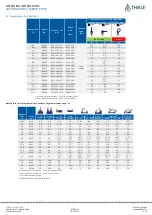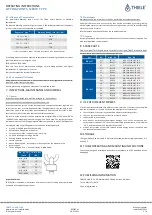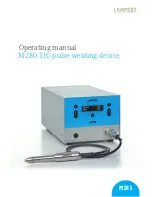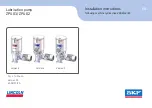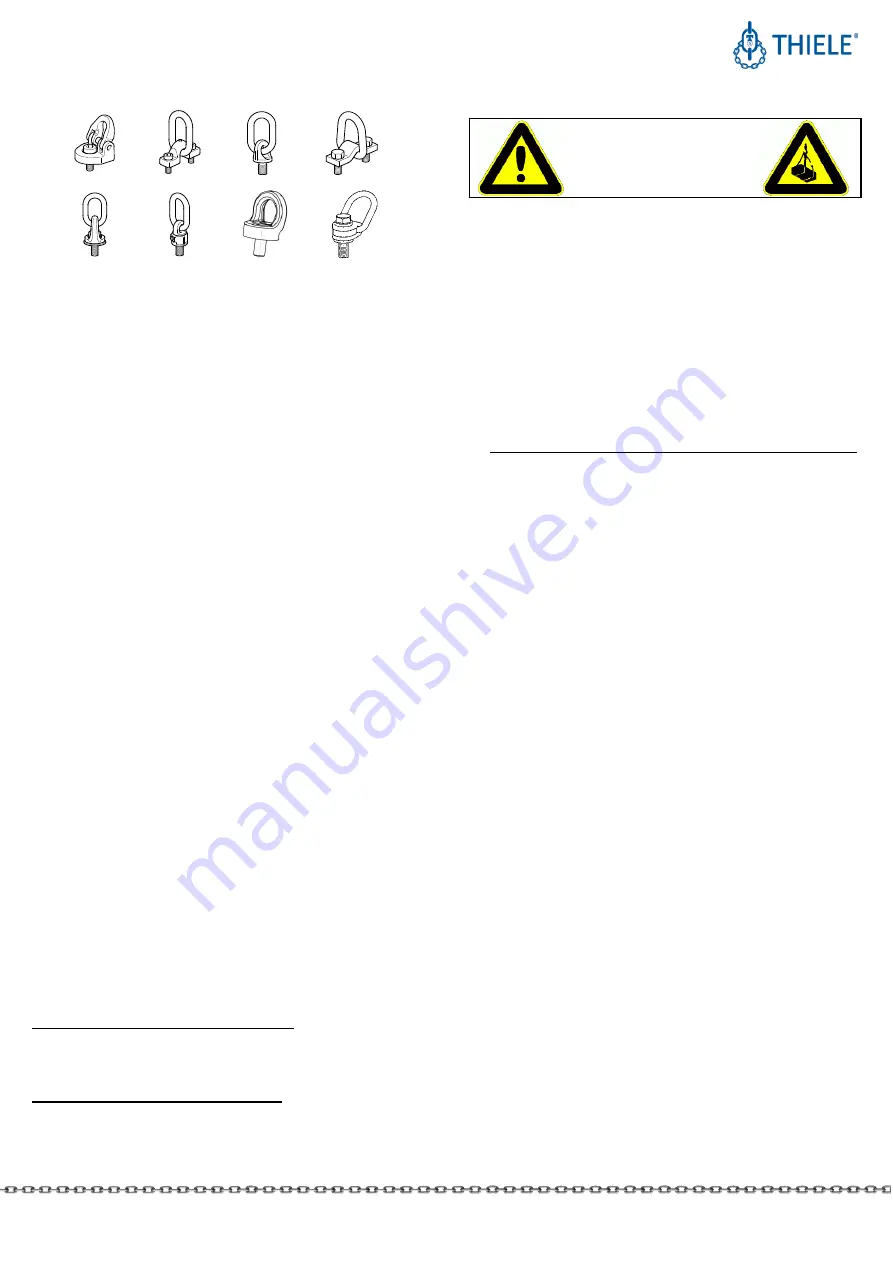
OPERATING INSTRUCTIONS
LIFTING POINTS, SCREW TYPE
THIELE GmbH & Co. KG
# Change indicator
www.thiele.de | info@thiele.de
B07905-M
replaces B07905-L
© All rights reserved
EN 07.2021
1 | 6
Original in compliance with 2006/42/EC
TWN 0121/1
TWN 0122
TWN 0123
TWN 0127
TWN 1120
TWN 1830
TWN 1884
TWN 1890
1
DESCRIPTION AND INTENDED USE
THIELE lifting points screw-type are intended for attachment to steel, aluminum or
non-ferrous metal structures and components.
Sling chains according to EN 818-4 or lashing chains according to EN 12195 may be
used.
These Operating Instructions show the safety use of THIELE lifting points of the
following executions:
•
TWN 0121/1 Lifting points, rotabable, with slide bearing
•
TWN 0122 Lifting points
•
TWN 0123 Lifting points
•
TWN 0127 Lifting points MDB
•
TWN 1120 TITAN Lifting points, rotabable, with slide bearing
•
TWN 1830 X-TREME Lifting points, rotabable, with ball bearing
•
TWN 1884 KE-Eyebolt, rotabable, with ball bearing
•
TWN 1890 Lifting points XS-Point, rotabable
(TWN = THIELE workshop standard)
THIELE lifting points meet EG Machinery Directive 2006/42/EG requirements and
feature a safety factor of at least 4 based on the Working Load Limit (WLL).
THIELE lifting points are signed with the CE symbol.
They are also signed with the Working Load Limit (WLL) in tons or the chain size,
manufacturers mark (stamp
’H4’)
and identification number.
TWN 1830 are additionally marked with the date of manufacture in the form "
mm.yy
"
(
mm
= month,
yy
= year). Example: "1220" = production in December 2020
THIELE lifting points are designed to withstand 20 000 dynamic load changes under
maximum load conditions. In the event of higher loads (e.g. multi-shift/automati c
operation, magnetic spreaders) the Working Load Limit must be reduced.
Lifting points must exclusively be used
•
within the limits of their permissible working load limit,
•
within the temperature limits prescribed,
•
with suitable screws (see screw data) and fitted directly to the component.
The Working Load Limit of different modes of assembly can be seen in the load table.
THIELE lifting points are normally not intended for passenger transportation.
Turning and rotating loads
•
TWN 0121/1
Turning allowed, rotating not allowed.
•
TWN 0122
Turning allowed, rotating not allowed.
•
TWN 0123
No turning and/or rotating allowed.
•
TWN 0127
Turning allowed, rotating not allowed.
•
TWN 1120
Turning allowed, rotating not allowed.
•
TWN 1830
Turning and rotating allowed.
•
TWN 1884
Turning allowed, rotating not allowed.
•
TWN 1890
Turning allowed, rotating not allowed.
This classification relates to occasionally turning or rotating loads.
Continous or long-term turning or rotating is not allowed.
Using the lifting points exclusively for lashing the Lashing Capacity is calculated by
doubling the Working Load Limit.
An alternating use for lifting and lashing is not allowed.
2
SAFETY NOTES
Risk of Injury!
Never walk or stay under lifted loads!
Make sure to use hoisting/ attach me n t
means free from defects.
•
Operators, fitters, and maintenance personnel must in particular observe the
Operating Instructions also from the used sling chain assemblies, documentations
DGUV V 1, DGUV R 100-500 Chapter 2.8 and DGUV I 209-013 issued by the German
Employers’ Liability
Insurance Association, as well as the Operating Instructions of
the loads concerning advise for lifting.
•
In the Federal Republic of Germany, the Operational Safety Ordinance (BetrSichV)
has to be implemented and the Technical Rule for Industrial Safety TRBS 1201, in
particular Annex 1, Chapter 2 "Special regulations for the use of workin g
equipment for lifting loads" must be observed.
•
Outside the Federal Republic of Germany the specific provisions issued locally in
the country where the items are used must also be observed.
•
The directions given in these Operating Instructions and specified documentations
relating to safety, assembly, operation, inspection, and maintenance must be
made available to the respective persons.
•
Make sure these Operating Instructions are available in a place near the product
during the time the equipment is used.
•
Please contact the manufacturer if replacements are needed.
•
When performing work make sure to wear your personal protective equipment!
•
Improper assembly and use may cause pe rsonal injury and/or damage to
property.
•
Assembly and removal as well as inspection and maintenance must exclusively be
carried out by skilled and authorized persons.
•
Structural changes are impermissible (e.g. welding, bending).
•
Operators must carry out a visual inspection and, if necessary, a functional test
of the safety equipment before each use.
•
Never use worn-out, bent or damaged lifting points.
•
Only lift loads the mass of which is less than or equal to the working load limit of
the lifting points.
•
Do not use force when mounting/positioning the lifting points .
•
Only lift loads that are freely movable and not attached or fastened .
•
Do not bend the ring or suspension link.
•
Do not start lifting before you have made sure the load has been correctly
attached.
•
Make sure no one including you (operator) is in the way of the moving load (hazard
area).
•
During lifting/hoisting make sure your hands or other body parts do not come into
contact with hoisting means. Only remove hoisting means manually (use your
hands).
•
Avoid impacts, e.g. due to abruptly lifting loads with chain in slack condition.
•
Never move a suspended load over persons.
•
Never cause suspended loads to swing.
•
Always monitor a suspended load.
•
Put the load only down in places/sites where it can be safely deposited.
•
Put the load only down in flat places/sites where it can be safely deposited.
•
Take care for sufficient place for the personnel to move when choosing the route
of transportation and storage location. Danger to life and risk of injury by crushing
hazards!
•
In the event of doubts about the use, inspection, maintenance or similar things
contact your safety officer or the manufacturer!
THIELE will not be responsible for damage caused through non-observance of the
instructions, rules, standards and notes indicated!
Working under the influence of drugs, medications impairing the sense and/or
alcohol is strictly forbidden!


